How To Grow And Care For Calathea Makoyana
Written by Ivy
Nov 30 2021
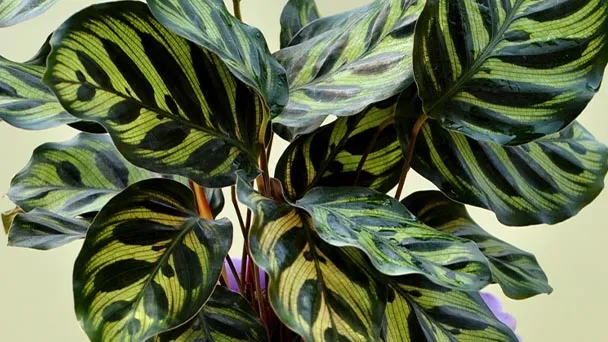
When it comes to office potting, Calathea makoyana is a very recommended indoor foliage potting. Calathea makoyana is a perennial evergreen herb of Bambusoideae. Its leaves have dark green and white or light yellow feather markings, like the pattern of peacock tail feathers, so it is called Calathea makoyana.
Calathea makoyana's unique leaf shape has high ornamental value and is very shade resistant. It is an ideal indoor potted plant, so it is loved by many people. Calathea makoyana leaves may fold up at night. In fact, this is a characteristic of Calathea makoyana. It is a normal phenomenon, not a plant healthy problem.
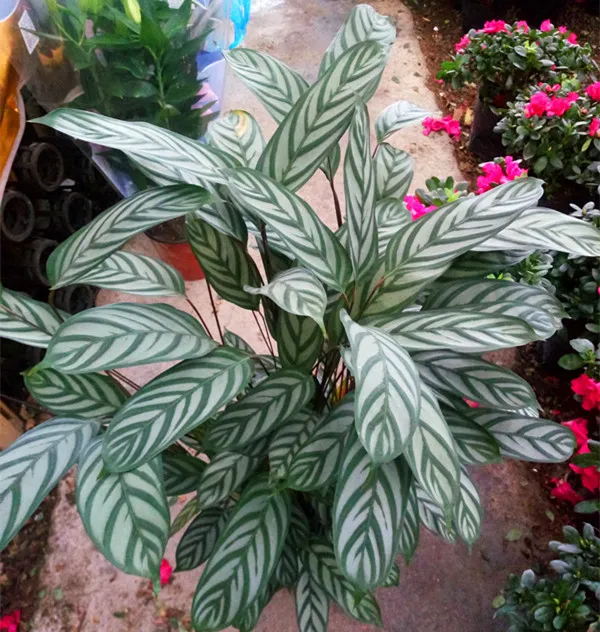 Calathea makoyana will bloom, but it is not easy to see at flowering. It begins to bloom in winter every year, and the flowering period is relatively short. A single flower only opens for 1-2 days. The open flowers of Calathea makoyana are white and not so conspicuous. Whenever Calathea makoyana blooms, it means a better life, and the days in the future will be colorful.
Calathea makoyana will bloom, but it is not easy to see at flowering. It begins to bloom in winter every year, and the flowering period is relatively short. A single flower only opens for 1-2 days. The open flowers of Calathea makoyana are white and not so conspicuous. Whenever Calathea makoyana blooms, it means a better life, and the days in the future will be colorful.
Whether Calathea makoyana needs watering depends on the degree of moisture in the pot soil. If the surface of Malachite taro cultivated in sandy soil is slightly dry, it can be watered once in three days. If it is a soil with poor porosity, it should be watered a little less.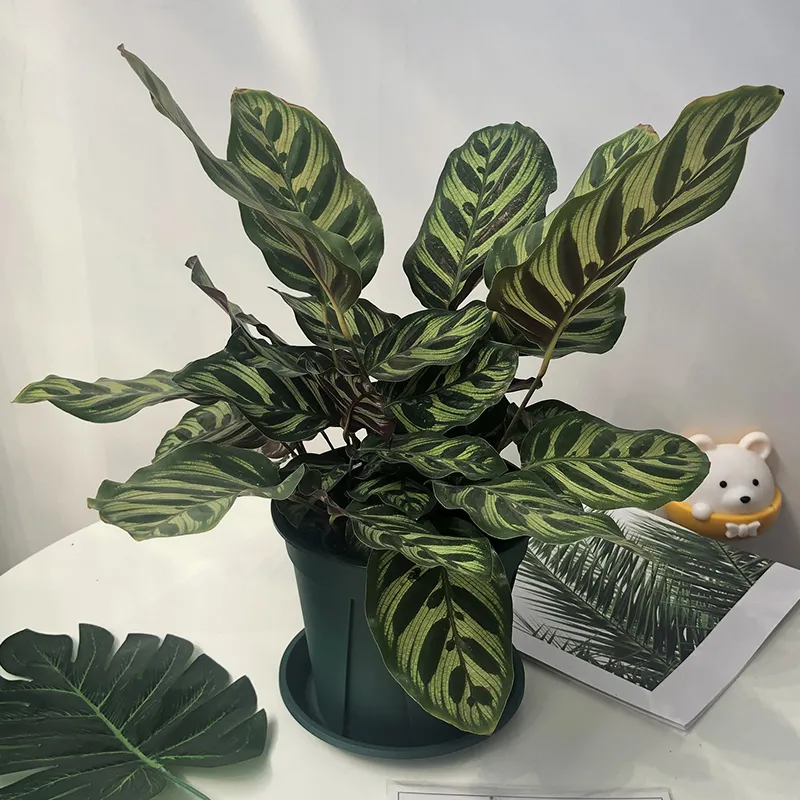
Calathea makoyana grows rapidly, so its branches and leaves are lush. The branches and leaves with irregular growth shall be cut off in time to avoid the old leaves blocking the deformation of new leaves. After pruning, it can not only make the appearance of Calathea makoyana more beautiful, but also enhance the light transmittance and air permeability, reduce the possibility of diseases and pests, and promote the healthy growth of Calathea makoyana in the later stage.
After Calathea makoyana grows for a period of time, the root system is relatively developed, so we can trim the root system. When changing pots for Calathea makoyana, we can cut off the dead and rotten roots first, and then properly cut the over dense and excessive root system to retain the healthy root system without affecting the root system's absorption of water and nutrients.
When changing pots for Calathea makoyana, we should avoid the cold period, so as not to prevent the low temperature from hindering the germination of new roots and affecting the pot serving of plants. The best time to change pots is around April in spring, when the light is relatively mild and the temperature basically tends to be stable (about 20 ℃), coupled with the strong activity of Calathea makoyana at this time, so choosing to change pots at this time can accelerate the growth of new roots and greatly improve the success rate of pot change.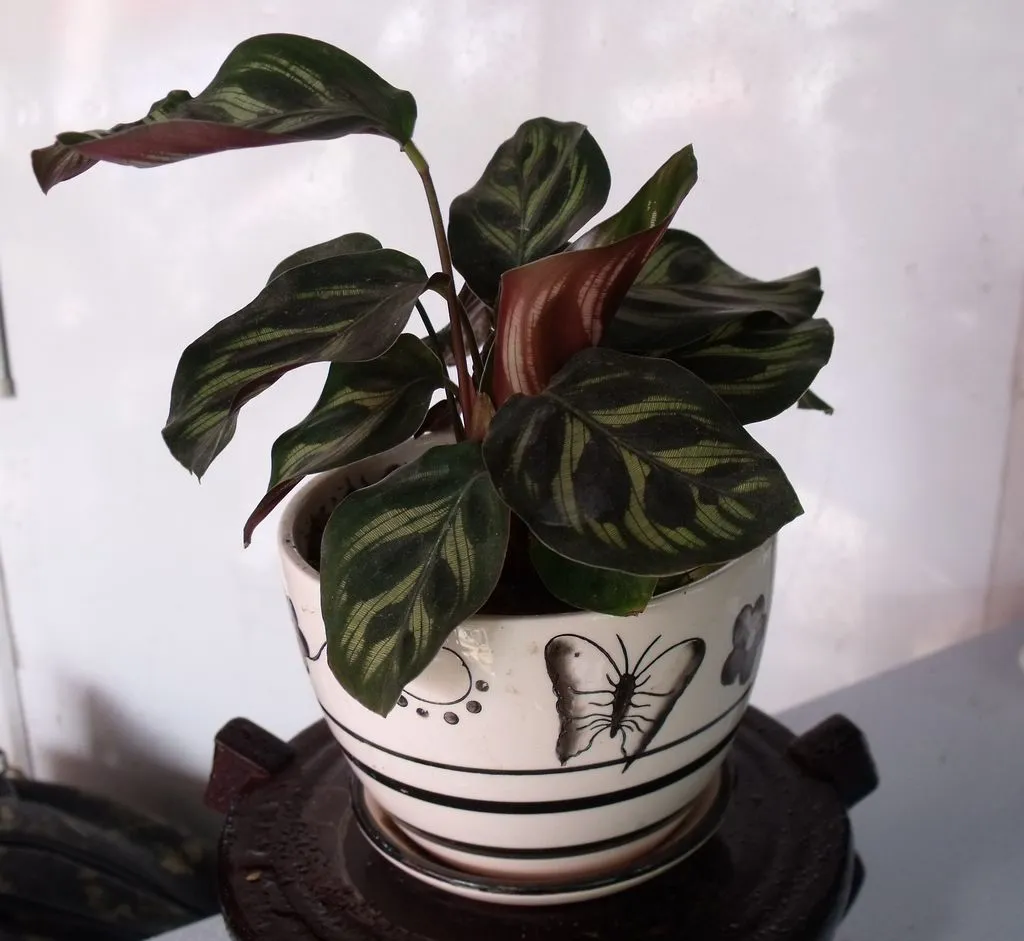
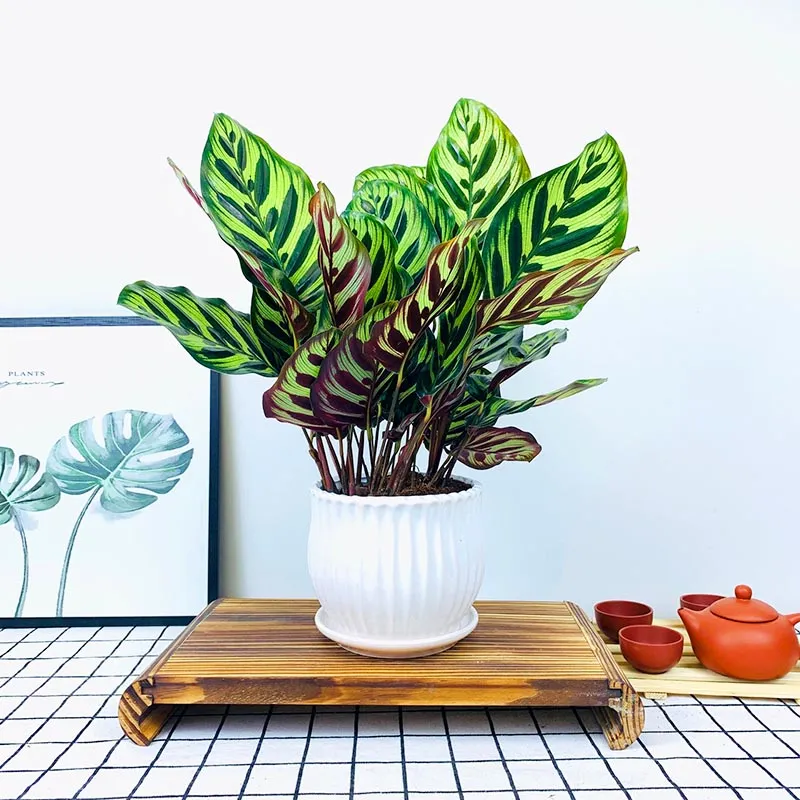 The split plant method is the most commonly used breeding method of Calathea makoyana, and the survival rate is very high. It is best to grow in summer every year. Calathea makoyana grows many rhizomes in the second half of each year, and the rhizomes can be separated from the mother plant with a knife.
The split plant method is the most commonly used breeding method of Calathea makoyana, and the survival rate is very high. It is best to grow in summer every year. Calathea makoyana grows many rhizomes in the second half of each year, and the rhizomes can be separated from the mother plant with a knife.
When branching, we can first take the mother plant of Calathea makoyana out of the flower pot, and then select a suitable position for branching. We can use a knife to cut the plant from the place with 3-4 buds as a seedling. Then we can apply some charcoal powder on the wound to help prevent corrosion, and then find a new soil for planting the separated rhizomes, place them in a cool place for breeding, maintain the moisture of the soil, and wait for the rhizomes to take root and sprout.
After the pot is put on, water it immediately, pay attention to watering enough water, and place it in a cool place to successfully spend the seedling exchange period. The normal maintenance and management can be carried out after the seedlings are successfully retarded for about one week. At the initial stage of Calathea makoyana propagation from division, water shall be controlled and fully watered after new roots are developed.
Calathea makoyana's unique leaf shape has high ornamental value and is very shade resistant. It is an ideal indoor potted plant, so it is loved by many people. Calathea makoyana leaves may fold up at night. In fact, this is a characteristic of Calathea makoyana. It is a normal phenomenon, not a plant healthy problem.
Calathea Makoyana Quick InfoWhen does Calathea Makoyana Bloom & HarvestCalathea Makoyana Care in DetailCalathea Makoyana WateringCalathea Makoyana SoilCalathea Makoyana LightCalathea Makoyana TemperatureCalathea Makoyana HumidityCalathea Makoyana FertilizerCalathea Makoyana PruningCalathea Makoyana RepottingCalathea Makoyana Pest & Disease Control1. Leaf spot2. Scale insect3. Starscream4. AphidCalathea Makoyana PropagationCalathea Makoyana Propagation from CuttingCalathea Makoyana Propagation from Division
Calathea Makoyana Quick Info
| Botanical/Scientific Name | Calathea Makoyana |
| Common Name | Peacock Plants |
| Uses | Purifies the air |
| Origin | Eastern Brazil |
| Light Care | Bright, indirect sunlight |
| Soil Care | Consistently moist soil |
| Temperature Care | 60-75°F (16-24°C) |
| Humidity Care | High humidity of 60 % or more |
| Watering | Water it thoroughly when the top inch of the soil is dry |
| Pruning Care | Prune bloom and dead, dying or damaged leaves |
| Fertilizer Care | Liquid or water soluble fertilizer |
| Propagation | Division |
| Toxic | Non-toxic to cats and dogs |
| Flower Color | White |
When does Calathea Makoyana Bloom & Harvest

Calathea Makoyana Care in Detail
Calathea Makoyana Watering
Calathea makoyana is a water loving plant. During its growth, Calathea makoyana needs a lot of water supply, especially in summer and autumn, when the evaporation is large, it is necessary to check the soil humidity from time to time. Once it is dry, it is necessary to water it in time, and spray water mist on the plants from time to time, so as to achieve the effect of cooling and moisturizing. If we want to raise a basin of water, Calathea makoyana should also pay attention to the management of air humidity, but frequent watering does not mean that water will accumulate in the soil, otherwise it will be detrimental to growth.Whether Calathea makoyana needs watering depends on the degree of moisture in the pot soil. If the surface of Malachite taro cultivated in sandy soil is slightly dry, it can be watered once in three days. If it is a soil with poor porosity, it should be watered a little less.
Calathea Makoyana Soil
Loose, fertile, well drained and humus rich slightly acidic loam should be used for Calathea makoyana potting. We can generally mix 3 parts of rotten leaf soil, 1 part of peat or sawdust and 1 part of sand, and add a small amount of bean cake as base fertilizer. Do not use viscous garden soil. When we put the basin on Calathea makoyana, we can pad 3cm thick coarse sand on the basin bottom as a drainage layer to facilitate drainage.Calathea Makoyana Light
The illuminance of Calathea makoyana should be 30% - 40%. It grows well under indoor scattered light. It should be cultivated in loose, fertile and well drained soil. It can be placed in a bright indoor light for maintenance in spring and autumn. In summer, we should put Calathea makoyana in a half shade for maintenance. Too strong light makes the leaves yellow and scorched, affecting its ornamental value. In winter, the light intensity decreases. Calathea makoyana can be moved to the south window for cultivation. At this time, the growth environment should not be too shaded. If placed in a dark place for a long time, the leaves of Calathea makoyana will lose their unique luster!Calathea Makoyana Temperature
Unlike some plants, Calathea makoyana has high requirements for room temperature. Because Calathea makoyana is not resistant to cold in winter and the room temperature is above 8 ℃, malachite taro can survive the winter safely. We should place it in a place with good light for cultivation. The basin soil should not be too wet, and it is better to be dry. If the indoor temperature in winter can reach above 15 ℃, Calathea makoyana can survive the winter safely.
Calathea Makoyana Humidity
Calathea makoyana likes a humid environment and can be watered more during normal growth period. However, due to the low temperature in winter, Calathea makoyana will enter a dormant state. It is necessary to start water control and keep the basin soil in a dry state. After spring, we have to wait for the leaves of Calathea makoyana to grow and slowly return to normal watering.Calathea Makoyana Fertilizer
In the peak growth season of Calathea makoyana, we need to apply thin liquid fertilizer every half a month. When applying fertilizer, we should pay attention not to apply too much nitrogen fertilizer. Otherwise, the markings on the leaves of Calathea makoyana will fade, the thickness of the leaves will increase, the petiole will become soft, and serious dysplasia will occur. For the use of fertilizer, it is generally recommended to use nutrient balanced fertilizer. This proportion of fertilizer can make the leaf color of Calathea makoyana more shiny. We must not use a large amount of large nitrogen fertilizer, which will be particularly unfavorable to its germination and growth.Calathea Makoyana Pruning
During the growth and breeding process of Calathea makoyana, withered and yellow branches and leaves may appear due to improper maintenance, so the branches and leaves should be trimmed. During daily maintenance, if we find that Calathea makoyana has withered and yellow branches and leaves, we can cut them off in time, which can reduce the consumption of nutrients and avoid affecting the beauty.Calathea makoyana grows rapidly, so its branches and leaves are lush. The branches and leaves with irregular growth shall be cut off in time to avoid the old leaves blocking the deformation of new leaves. After pruning, it can not only make the appearance of Calathea makoyana more beautiful, but also enhance the light transmittance and air permeability, reduce the possibility of diseases and pests, and promote the healthy growth of Calathea makoyana in the later stage.
After Calathea makoyana grows for a period of time, the root system is relatively developed, so we can trim the root system. When changing pots for Calathea makoyana, we can cut off the dead and rotten roots first, and then properly cut the over dense and excessive root system to retain the healthy root system without affecting the root system's absorption of water and nutrients.
Calathea Makoyana Repotting
It is more important for Calathea makoyana to change pots in time, because the leaves of Calathea makoyana are large and plump, the plant growth rate is relatively fast, and a large amount of nutrient supply is required to meet the growth needs of the whole plant. In addition, due to the rapid growth of Calathea makoyana, the old basin can not better accommodate the whole plant after growing to a certain extent, which virtually hinders the downward extension of root system and is not conducive to the development of root system. Only timely replacement of basin soil can well solve a series of problems such as limited growth space and insufficient nutrients in basin soil, so as to better promote the growth of peacock bamboo taro, Let the leaves emit charming colors.When changing pots for Calathea makoyana, we should avoid the cold period, so as not to prevent the low temperature from hindering the germination of new roots and affecting the pot serving of plants. The best time to change pots is around April in spring, when the light is relatively mild and the temperature basically tends to be stable (about 20 ℃), coupled with the strong activity of Calathea makoyana at this time, so choosing to change pots at this time can accelerate the growth of new roots and greatly improve the success rate of pot change.

Calathea Makoyana Pest & Disease Control
1. Leaf spot
Calathea makoyana has strong adaptability. Calathea makoyana also suffers from leaf spot disease in high temperature and unventilated environment.- Symptoms: in the early stage, there are small yellowish brown spots on the leaves and halos on the edges; In severe cases, Calathea makoyana spots quickly spread to each branch and leaf of konjac, eventually leading to konjac wilting and death.
- Control method: after we found Calathea makoyana leaf spot, in order to reduce the occurrence of the disease, all the diseased branches should be removed and sprayed with relevant drugs. You can choose to spray 38% oxacillin copper 800-1000 times or 4% fluorosilazole 1000 times every other week for three consecutive times.
2. Scale insect
In addition to diseases, Calathea makoyana is also affected by pests. The most common encounter is scale insects, which attach to leaves and absorb nutrients and water.- Symptoms: scale insects can cause poor growth of Calathea makoyana and other diseases, directly leading to the death of Calathea makoyana.
- Control method: when the pest is small, we can use brush to handle it manually; If a large number of earthworms are found, they need to be sprayed for control. Select 1500 times of 50% malathion solution or 1000 times of 255 imiphos solution, spray once a week and twice continuously.
3. Starscream
Red spider is one of the common pests endangering Calathea makoyana. This insect often appears when ventilation is poor and can damage the top of the plant.- Symptoms: Calathea makoyana may have reddish brown tops and cobwebs, affecting plant growth and development.
- Control methods: after diseases and pests are found, drugs such as killing natural enemies, spraying 25% emulsion 800 times and 73% acaroid 2000 times can be used for treatment.
4. Aphid
If we find that Calathea makoyana has long insects, it may be aphids. It usually appears on young leaves and buds and feeds on the juice of leaves.- Symptoms: the leaves of Calathea makoyana turn yellow with black or yellow spots.
- Control method: spraying 40% dimethoate 1500 times solution or 90% trichlorfon solution at the initial stage of aphid occurrence can control aphids. At ordinary times, we should pay attention to reasonable watering and fertilization to improve its ability to resist diseases and pests.
Calathea Makoyana Propagation
Calathea Makoyana Propagation from Cutting
Calathea makoyana propagation from cutting can be carried out in summer. First, we can select young branches with 2 to 3 leaves at the base as cuttings, or use some kinds of creeping branches for cutting. calathea makoyana propagation from cutting has high requirements for matrix, which needs well drained and rich humus. We can mix half of peat soil and river sand, or use vermiculite and perlite as matrix to keep it moist. We can take root and plant in pots in about 5 weeks.Calathea Makoyana Propagation from Division

When branching, we can first take the mother plant of Calathea makoyana out of the flower pot, and then select a suitable position for branching. We can use a knife to cut the plant from the place with 3-4 buds as a seedling. Then we can apply some charcoal powder on the wound to help prevent corrosion, and then find a new soil for planting the separated rhizomes, place them in a cool place for breeding, maintain the moisture of the soil, and wait for the rhizomes to take root and sprout.
After the pot is put on, water it immediately, pay attention to watering enough water, and place it in a cool place to successfully spend the seedling exchange period. The normal maintenance and management can be carried out after the seedlings are successfully retarded for about one week. At the initial stage of Calathea makoyana propagation from division, water shall be controlled and fully watered after new roots are developed.
Latest Updated
- Benefits of Bugleweed - 7 Science-backed Health Benefits
- Bugleweed Dangers & Side Effects - Is It Poisonous?
- How to Plant Evergreen Trees - What You Should Know
- When to Plant Evergreens - Grow Guide for Evergreen Trees
- 12 Wonderful Evergreen Shrubs for Your Garden
- 12 Popular Evergreen Plants with Pictures for Beginners
- When And How To Prune A Lilac Bush Like a Pro
- How to Grow & Care for Lilac Vine (Hardenbergia Violacea)
- Japanese Lilac Tree (Syringa Reticulata) Care & Propagation Guide
- Shumard Oak Pros and Cons - What to Know
Popular Articles
- Winter maintenance of Antirrhinum Majus
- How to Grow Terminalia Mantaly Tree
- How to Grow and Care for Crossostephium Chinense
- How to grow Antirrhinum Majus in spring
- Peristeria Elata (Dove Orchid) Profile: Info & Care Guide
- Underwatered Snake Plant (Sansevieria Trifasciata) - Signs And How To Fix
- How to Care for Brazilian Jasmine Plant (Mandevilla Sanderi)
- How to Grow & Care for Graptopetalum Purple Delight in Summer
- Rosa Chinensis (China Rose): Plant Growing & Care Tips
- How to Care for Baby Sun Rose (Aptenia Cordifolia)